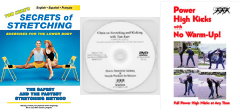by Thomas Kurz
Hook Kick—Correct Form
Correct form of the hook kick (karate’s ushiro mawashi geri and taekwondo’s bakkat dollyo chagi)
— Stand with the kicking side closer to the target, and look at the target.
— Transfer your weight to your supporting leg, its knee bent, the supporting foot firmly planted on the ground, toes pointing away from the target.
— Raise the kicking leg up, so its knee is above your waist and the outside surface of its thigh is directed toward the target. This looks similar to the chamber for the roundhouse kick, except you are not aiming at the target with your knee but rather with your hip, while the knee is closer to your center line. The kicking leg is less folded than in the roundhouse kick.
— Relax your hips. Throw your hip toward the target as you simultaneously lower your trunk. Snap the kicking leg at the target, as if to hook it with your heel and bring it to your buttock. Your kicking leg should travel along a horizontal line to generate power and to bypass the guard.
Hook Kick Errors
1. Kicking too low or too slow.
Cause: Poor flexibility or poor balance or both. Practice the hook kick at first very slowly—holding on to a chair, for example—paying attention to the correct path of the kick and sufficient range of motion while staying as relaxed as possible. Gradually increase the speed of the snap and the whole movement. Practice leg raises to the side as taught in my article “High Kicks with No Warm-Up: The Right Body Alignment for Side Kicks” and on the DVD Clinic on Stretching and Kicking.
2. Jamming the kick on the opponent’s guard.
Cause: Horizontal part of the kick is too short.
Remedy: Raise the leg higher before snapping. Practice kicking above partner’s extended arms—as your partner spreads arms apart, you learn to extend the horizontal part of the kick.
Spinning Hook Kick—Correct Form
— Stand with the kicking side farther from the target, so in a front stance, for example, you will kick with your rear leg.
— Spot your target. That means look at it before the turn, so when you complete the turn you see the same spot again.
— Plant your leading foot, and turn your body without turning your head.
— Then pivot on the toes of the leading foot as you twist tightly by first spinning your head, then shoulders, then hips, and at last the kicking leg. A quick turn of the head is essential to guarantee a fast and powerful spin of your whole body. Remember: Before turning your head, pick a spot at your eye level in front of you and turn fast. Set your eyes on this spot again. Turn fast to minimize the time you do not see this spot.
— Put the spin and the snapping and hooking action together. That means spin and let your kicking leg fly out—after a few tries you will know when to let the leg snap out so it raises high enough and travels along the horizontal line long enough. Begin with kicks at about your waist level, or even lower if that is too difficult. As your skill at spinning and snapping the leg grows, kick higher.
— Pull your kicking leg behind you after the impact. Do this by pulling with your hip in the direction of the kick and then adding a twist of your upper body to pull the leg down.
Spinning Hook Kick Errors
1. Impact at less than 180° of the turn, and the kick lands short of a full turn. This forces the kicker to get closer to the target than with the correct kick and to aim off to the side.
Cause: Poor flexibility or being too tense. Not dropping the trunk deep enough or raising it too soon so it forces the hip down. Not enough practice of spinning with correct “spotting” of the target.
Remedy: Practice leg raises to the side, hook kicks in slow motion with deep lean of the trunk, spinning with spotting but without kicking, and spinning with hook kicks, initially low and then gradually higher. Throw your hip toward the target and then pull it back. Pull your kicking leg behind you after the impact.
2. Impact at more than 180° of the turn—past the target.
Cause: Kicking leg raised too late during the spin.
Remedy: Spin and kick over a chair or above a table. The obstacle will force you to raise your knee early and high and to extend your hip and leg toward the target.
In the next article you will learn how to fix errors in the back kick.
If you have any questions on training you can post them at Stadion’s Sports and Martial Arts Training Discussion Forum.
Get the most to-the-point info on the fastest method of achieving high kicks and splits with no warm-up!
On these three DVDs you will find the best instruction on flexibility and stretching for martial arts, such as karate, kickboxing, kung-fu, taekwondo—any arts that employ high kicks.
Click here to save 25% off the regular price of $129.85! Buy these three DVDs in our Kicker’s Bundle for $97.39 and save $32.46!

